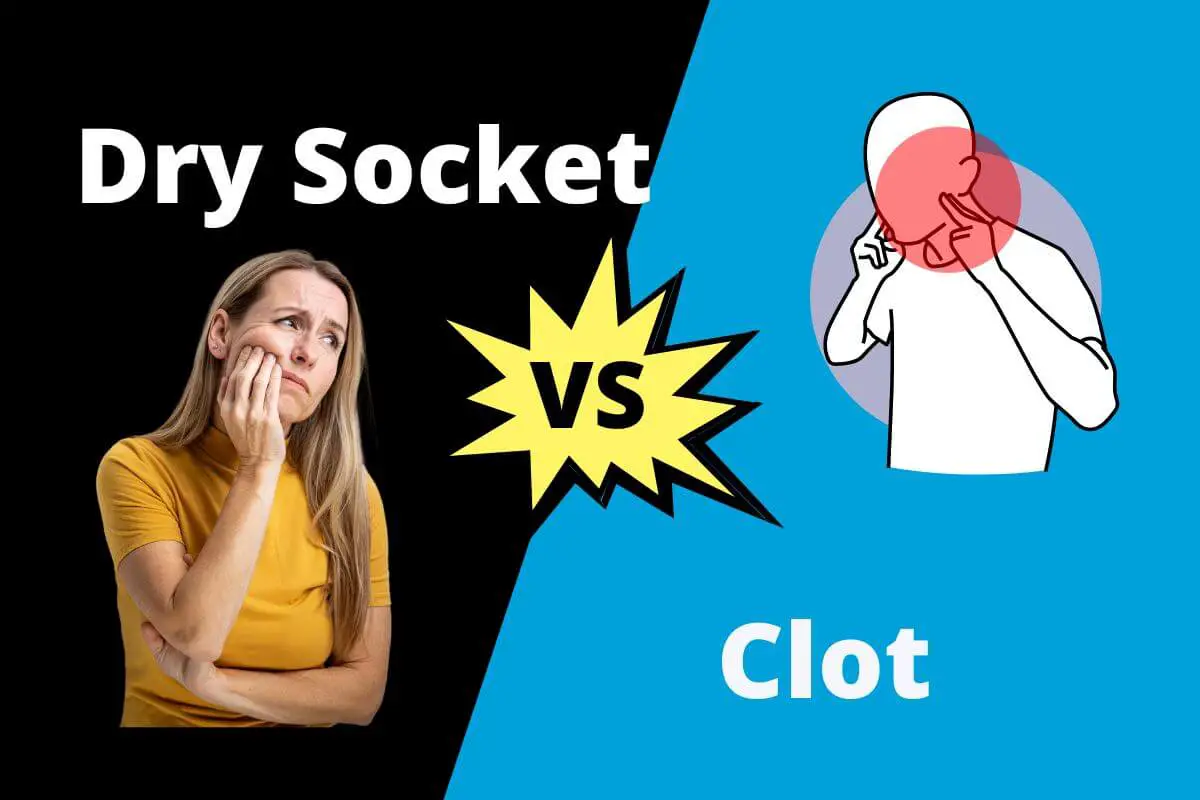After a tooth removal, a blood clot covers the underlying bone and sensory endings, allowing for healing. Dry sockets occur when the clot has never formed or is ejected too early.
Regular sockets will form a blood clot after tooth extraction that will remain in place. At the same time, the incision heals and gradually reduces discomfort. The blood clot may partly or entirely separate from the incision in a dry socket, which may make the suffering worse.
Table of Contents
Dry Socket vs Clot: Understanding the Differences
| Dry Socket | vs | Clot |
| Happens when the clot doesn’t heal and exposes the nerves and bones underneath | Definition | A wet scab or clot that forms at the extraction site |
| Excruciating pain, swelling, and infections | Symptoms | Swelling and pain |
| Consult the dentist or oral hygienist for pain relievers | After Care | Eat soft food and take it easy |
Meaning
After tooth extraction, a blood clot covers the underlying bone and sensory endings, which becomes painful. The clot is crucial to the healing process because it permits bone regrowth and the replacement of missing soft tissue with new tissue.
An empty socket after a wisdom tooth removal often heals on its own, and any discomfort experienced during the treatment eventually subsides.
However, dry socket form when the clots either cease to form or eject before the incision heals. Learn more about dry sockets from the American Dental Association.
Symptoms
Severe pain results from the exposed bone and nerve but will subside once the clot heals. But if it doesn’t heal, the throbbing pain stretches along the jawline to the part of your face and not only at the extraction site. The tooth socket may irritate and fill with food bits, only worsening discomfort.
A dry socket becomes potentially more excruciating than the extraction itself. The symptoms of dry socket include pain and infection. Although it is a common complication, it may cause agonizing discomfort that may throb and spread across the whole jaw or upwards into the ear.
After Care
Apply pressure on the extraction site and consume only soft food for a few days until the clot heals properly. If it gets worse and turns into a dry socket. In that case, you must consult your dentist and take necessary pain medications and anti-inflammatory drugs like ibuprofen.
What Does a Clot Look Like?
After you undergo a wisdom tooth extraction, you will notice a clot in the empty socket. It looks like a blood clot or scab but can be wetter than typical. The clot will eventually heal and grow smaller.

How to Protect a Clot After Undergoing an Extraction?
Your dentist or oral hygienist might give you a list of instructions to follow post extra, which will help you protect the clot and ensure it heals quickly. If they haven’t, here are a few essential tips to keep in mind:
Put Pressure on the Site
The doctor will ask you to bite on gauze to stop the bleeding at the extraction site. The bleeding stops after around 30 minutes, and the clot can form. Bite down on the gauze, and if the bleeding doesn’t stop within 45 minutes, you must change the gauze and apply pressure for 2 hours.
Help the Clot to Develop
Once the bleeding stops completely, you can help your body form and heal a clot. You must avoid creating a vacuum or sucking motion inside the mouth. You can do that by:
- Don’t use straws
- Don’t spit
- Avoid smoking
- Don’t chew on the extraction site
Treat Swelling and Pain
It’s normal to have pain and swelling. Use an ice pack to treat the swelling and take necessary medications for pain relief.
Have Soft Food
When the swelling and pain become too much, it might become difficult for you to chew. Stick with soft foods to prevent intense pain and help the clot to form.
Take It Easy
Take it easy not just on the first day after the extraction but also for the next 3-4 days. Even if you feel healthy and there’s not much pain, you should rest properly and limit vigorous activity for at least two days. Besides that, practice good oral hygiene.

How to Avoid Dry Sockets
- Make sure your oral surgeon or dentist has expertise in this operation. Look at their qualifications, read internet reviews, and ask around. Research your dentist’s degrees and accreditations.
- After deciding on a care provider, discuss any over-the-counter or prescription pills you are presently taking with them. Certain drugs like oral contraceptives may stop your blood clots from forming, resulting in a dry socket.
- Limit or avoid cigarettes and other tobacco products before and after your operation if you smoke. Smoking increases your risk of dry socket. Discuss nicotine control strategies with your dentist, such as the patch, during the healing phase. They could even offer advice on how to stop using nicotine and/or tobacco products altogether.
After Your Tooth Extraction
Your dentist will provide information on healing and basic post-operative instructions after oral surgery for dry socket treatment. Carefully follow their instructions.
You can expect your dentist to address rinsing with mouthwash, brushing your teeth, and ensuring proper oral health. Ask your dentist any questions you have. They can calm any worries you may have.
Be on the Lookout for Dry Socket
After having a tooth pulled, pay attention to your recovery process. Remember that if you encounter a dry socket, the most significant sign you will notice is growing discomfort, even if the surgery has been done a few days before.
As a result, it’s a good idea to keep track of your discomfort to decide if you need to get in touch with the dentist to have your wound examined.

